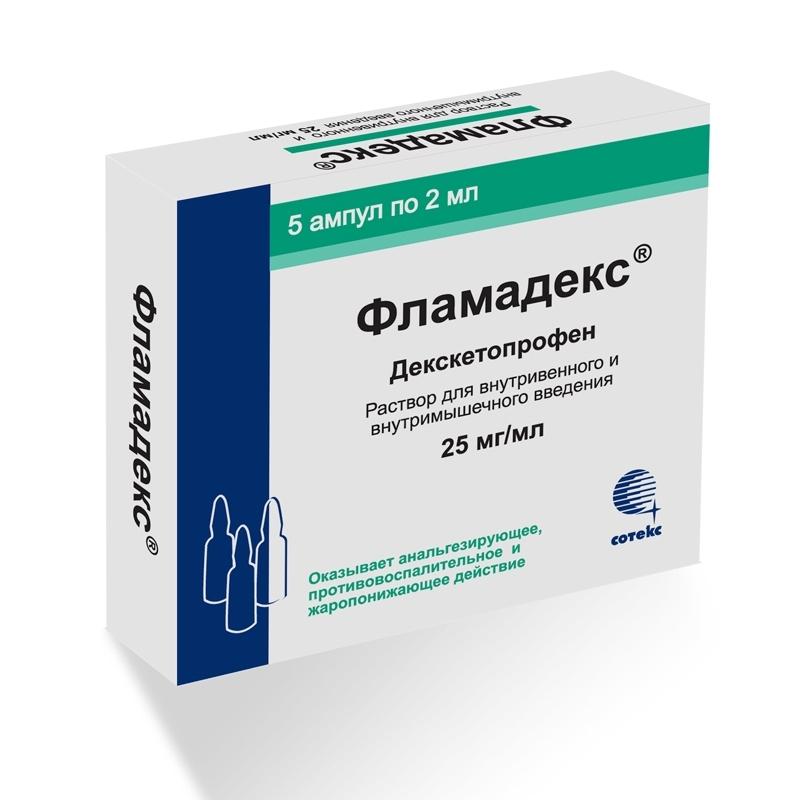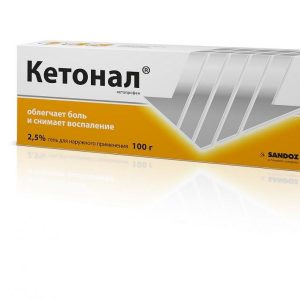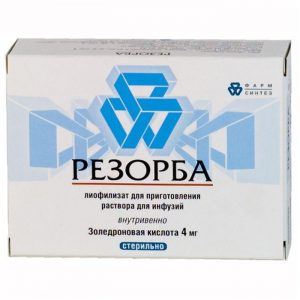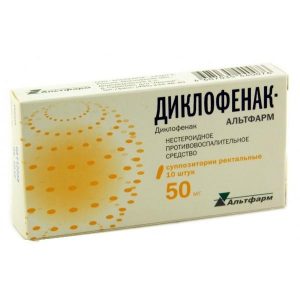Description
Release form
aerflf66 dlf1 aerosol pf1016fr1016frf661 solution for intravenous and intramuscular administration
Packing
5 ampoules.
Pharmacological action
Pharmacological action: Nonsteroidal anti-inflammatory drug (NSAID), a derivative of propionic acid. It has analgesic, anti-inflammatory and antipyretic effects. The mechanism of action is associated with inhibition of prostaglandin synthesis at the level of cyclooxygenase-1 and cyclooxygenase-2.
Analgesic effect occurs 30 minutes after parenteral administration. The duration of the analgesic effect after administration in a dose of 50 mg is about 4-8 hours.
When combined with opioid analgesics, dexketoprofen significantly (up to 30-45%) reduces the need for opioids.
Pharmacokinetics: Absorption After intramuscular (i / m) administration of dexketoprofen, the maximum concentration (Cmax) in blood serum is reached on average after 20 minutes (10-45 minutes). The area under the concentration-time curve (AUC) after a single administration at a dose of 25-50 mg is proportional to the dose, both with v / m and intravenous (iv) administration. The corresponding pharmacokinetic parameters are similar after a single and repeated IM or IV administration, which indicates the absence of cumulation of the drug.
Distribution Dexketoprofen is characterized by a high level of plasma protein binding (99%). The average value of Vd is less than 0.25 l / kg, the half-life is about 0.35 hours.
Excretion Dexketoprofen metabolism mainly occurs by conjugation with glucuronic acid followed by excretion by the kidneys. The half-life (T1 / 2) of dexketoprofen trometamol is about 1-2.7 hours. Pharmacokinetics in special clinical cases In elderly patients, an increase in the duration of T1 / 2 is observed (both after a single, and after repeated i / m or iv ) an average of 48% and a decrease in the overall clearance of the drug.
Indications
– relief of pain of various origins (including postoperative pain, pain with bone metastases, post-traumatic pain, pain with renal colic, algodismenorea, sciatica, radiculitis, neuralgia, toothache)
and symptomatic treatment of acute chronic inflammatory, inflammatory-degenerative and metabolic diseases of the musculoskeletal system (including rheumatoid arthritis, osteoarthritis, spondylitis: ankylosing spondylitis, reactive arthritis, psoriatic arthritis).
The drug is intended for symptomatic therapy, reducing pain and inflammation at the time of use, does not affect the progression of the disease.
Contraindications
– hypersensitivity to dexketoprofen or other NSAIDs or to any of the excipients that make up the drug (including sulfites)
– complete or incomplete combination of bronchial asthma, recurrent nasal polyposis and paranasal sinuses and acetone sinuses acid or other NSAIDs (including history)
– erosive and ulcerative lesions of the gastrointestinal tract and duodenum
– a history of gastrointestinal bleeding, other active bleeding (including suspected intracranial bleeding),
anticoagulant therapy – inflammatory bowel disease (ulcerative colitis, Crohn’s disease) in the acute stage
– severe hepatic impairment (10-15 Child-Pugh score)
– progressive kidney disease, severe renal impairment (creatinine clearance less than 30 ml / min)
– confirmed hyperkalemia
– decompensated heart failure
– period after coronary artery bypass grafting
– hemophilia and THER blood coagulation disorders
– pregnancy, breast-feeding
– child and adolescence to 18 years.
Flamadex ® is contraindicated for neuroaxial (epidural or intrathecal) administration due to the ethanol contained in the preparation.
Precautions: gastric and duodenal ulcer, ulcerative colitis, Crohn’s disease, history of liver disease, liver porphyria, chronic renal failure (creatinine clearance 30-60 ml / min), chronic heart failure, arterial hypertension, a significant decrease in circulating volume blood (including after surgery), elderly patients (including those receiving diuretics, debilitated patients with low body weight), bronchial asthma, concomitant use of glucocorticostero dov (including prednisone), anticoagulants (including warfarin), antiplatelet agents (including acetylsalicylic acid, clopidogrel), selective serotonin reuptake inhibitors (including citalopram, fluoxetine, paroxetine, sertraline), coronary heart disease, cerebrovascular disease, dyslipidemia / hyperlipidemia, diabetes mellitus, peripheral arterial disease, smoking, the presence of Helicobacter pylori infection, systemic connective tissue diseases, prolonged use of non-steroidal anti-inflammatory drugs, tuberculosis, severe osteoporosis, alcoholism, severe somatic diseases.
Special instructions
Flamadex ® should be used with caution in patients with a history of allergy. In patients with a history of gastrointestinal disturbances or with gastrointestinal diseases, a doctor s medical history is required, especially for gastrointestinal bleeding. In cases of gastrointestinal bleeding in patients taking dexketoprofen, the drug is immediately discontinued.
Caution is advised to administer the drug to patients taking concomitant drugs that may increase the risk of ulcers or bleeding: corticosteroids, anticoagulants (e.g. warfarin), selective serotonin reuptake inhibitors, or antiplatelet agents (including acetylsalicylic acid).
Dexketoprofen may cause reversible inhibition of platelet aggregation and increase bleeding time.
Flamadex ® should be used with caution in patients with NYHA functional class I-II chronic heart failure.
Like other NSAIDs, Flamadex ® can cause an increase in plasma creatinine and nitrogen, have a negative effect on the urinary system, leading to the development of glomerulonephritis, interstitial nephritis, papillary necrosis, nephrotic syndrome and acute renal failure.
As with other NSAIDs, there may be a slight transient increase in the performance of some liver samples, a significant increase in the activity of AST and ALT in the blood serum. At the same time, liver and kidney function monitoring is necessary in elderly patients. In the case of a significant increase in the relevant indicators, Flamadex ® should be canceled.
Flamadex ® should be used with caution in patients with impaired hematopoiesis, patients with systemic lupus erythematosus, or other connective tissue diseases.
Like other NSAIDs, Flamadex ® can mask the symptoms of infectious diseases. Isolated cases of exacerbation of infectious processes localized in the soft tissues with the use of NSAIDs have been reported. Therefore, medical supervision of patients with signs of bacterial infection or worsening during dexketoprofen treatment is required.
Caution should be exercised when administering the drug to patients with impaired liver, kidney, heart, or with conditions that may cause fluid retention in the body. In these patients, the use of NSAIDs can lead to deterioration and fluid retention in the body. Caution should also be exercised when prescribing dexketoprofen to patients using diuretics or predisposed to hypovolemia, since they increase the risk of developing nephrotoxicity.
Caution is necessary when prescribing the drug to the elderly, since they often reveal impaired renal, liver or cardiovascular system, as well as the occurrence of adverse reactions, such as gastrointestinal bleeding or intestinal perforation.
Each ampoule of Flamadex ® contains 200 mg of ethanol.
Effect on the ability to drive vehicles and other mechanisms that require an increased concentration of attention
Due to possible dizziness and drowsiness during treatment with Flamadex ®, a decrease in the ability to concentrate and speed psychomotor reactions is possible.
Release form.
Solution for intravenous and intramuscular administration of 25 mg / ml.
2 ml in ampoules of lightproof glass with a colored ring of a break or with a colored dot and a notch. In addition, one is applied to the ampoules, two or three color rings and / or two-dimensional bar code, and / or alphanumeric encoding or without additional color rings, two-dimensional bar code, alphanumeric encoding.
5 ampoules in blister packs of PVC film and aluminum foil or polymer film, or without foil and film.
1 or 2 blister strip packaging along with instructions for use in a pack of cardboard.
Storage conditions.
In the dark place at a temperature of no higher than 25 ° C. Keep out of the reach of children.
Expiration date.
2 years. Do not use after the expiration date indicated on the package.
Composition
1 amp. (2 ml): – dexketoprofen trometamol (in terms of dexketoprofen) 50 mg
Excipients: ethanol (95% ethyl alcohol in terms of 100% substance) 200 mg, sodium chloride 8 mg, sodium disulfite 2 mg, sodium hydroxide to pH 6.5-8.5, water for injection up to 2 ml
Description: clear, colorless solution .
Dosage and administration
Intramuscularly (deeply, slowly), intravenously (slowly for at least 15 sec) or drip (10-30 min).
Recommended adult dose: 50 mg every 8-12 hours. If necessary, re-administration of the drug with a 6-hour interval is possible. The daily dose should not exceed 150 mg. Flamadex® is indicated for short-term use, and treatment should be limited to a period of acute symptoms (no more than 2 days).
Impaired liver function.
In patients with mild to moderate hepatic impairment (5-9 points on the Child-Pugh scale), the total daily dose should be reduced to 50 mg and frequent monitoring of liver functional parameters should be carried out. Flamadex® should not be prescribed to patients with severe impaired liver function.
Impaired renal function.
For patients with mild renal impairment (creatinine clearance – 30-60 ml / min), the daily dose is reduced to 50 mg. Flamadex® should not be prescribed to patients with moderate or severe renal failure (creatinine clearance less than 30 ml / min).
Elderly patients.
Dose adjustment for elderly patients is usually not required, however, due to the physiological decrease in renal function, it is recommended to reduce the dose of the drug: total daily dose of 50 mg for mild renal impairment in elderly patients.
Rules for the preparation of solutions.
To prepare a solution of Flamadex® for IV infusion, the contents of one ampoule (2 ml) are diluted in 30-100 ml of 0.9% sodium chloride solution, glucose solution or Ringer’s solution. The solution should be prepared under aseptic conditions, protecting from exposure to daylight. The prepared solution should be transparent and colorless.
Side effects
Frequency of side effects: often (1-10%), infrequently (0.1-1%), rarely (0.01-0.1%), very rarely (less than 0.01%, including individual posts).
From the hemopoietic system: rarely – anemia very rarely – neutropenia, thrombocytopenia.
From the side of the central nervous system: infrequently – headache, dizziness, insomnia, drowsiness rarely – paresthesia.
From the sensory organs: infrequently – blurred vision rarely – tinnitus.
From the cardiovascular system: infrequently – arterial hypotension, a feeling of heat, hyperemia of the skin rarely – extrasystole, tachycardia, arterial hypertension, peripheral edema, superficial thrombophlebitis.
From the respiratory system: rarely – bradypnea very rarely – bronchospasm, dyspnea.
From the digestive system: often – nausea, vomiting infrequently – abdominal pain, dyspepsia, diarrhea, constipation, hematemesis, dry mouth rarely – erosive and ulcerative lesions of the gastrointestinal tract (GIT), including bleeding and perforation, anorexia, increased activity of liver enzymes, jaundice is very rare – damage to the pancreas, damage to the liver.
From the urinary system: rarely – polyuria, renal colic very rarely – nephritis or nephrotic syndrome.
From the reproductive system: rarely – in women – menstrual irregularities, in men – impaired prostate function.
From the musculoskeletal system: rarely – muscle spasm, difficulty in movement in the joints.
Dermatological reactions: sometimes – dermatitis, rash, sweating rarely – acne very rarely – photosensitivity.
Allergic reactions: rarely – hives very rarely – severe skin reactions (Stevens-Johnson syndrome, Lyell syndrome), angioedema, allergic dermatitis.
From the side of metabolism: rarely – hyperglycemia, hypoglycemia, hypertriglyceridemia.
On the part of laboratory parameters: rarely – ketonuria, proteinuria.
Local and general reactions: often – pain at the injection site infrequently – inflammatory reaction, hematoma, hemorrhage at the injection site, feeling hot, chills, fatigue rarely – back pain, fainting, fever very rarely – anaphylactic shock, facial swelling
Other: aseptic meningitis, which occurs mainly in patients with systemic lupus erythematosus or mixed connective tissue diseases, hematological disorders (purpura, aplastic and hemolytic anemia, rarely – agranulocytosis and bone marrow hypoplasia).
Drug interaction
General types of interaction characteristic of all NSAIDs, including dexketoprofen.
Undesirable combinations: – with other NSAIDs, including salicylates in high doses (? 3 g / day): the simultaneous use of several NSAIDs increases the risk of gastrointestinal bleeding and
ulcers – with oral anticoagulants, heparin in doses, exceeding prophylactic
– with ticlopidine (increased risk of bleeding due to inhibition of platelet aggregation and damage to the mucous membrane of the digestive tract)
– with lithium preparations – NSAIDs increase the concentration of lithium in blood plasma (decreased renal excretion of lithium), which can reach a toxic level, therefore, the level of lithium in the blood should be monitored when prescribing, changing the dose or canceling dexketoprofen
– with methotrexate in high (at least 15 mg / week) doses – toxicity increases methotrexate due to a decrease in its renal clearance when using NSAIDs
– with glucocorticosteroids: the risk of ulcers and gastrointestinal bleeding increases
– derivatives of hydantoin and sulfonamides: the severity of their toxic effects may increase.
Combinations, requiring caution: – with diuretics, ACE inhibitors, antibacterial drugs from the group of aminoglycosides and angiotensin II receptor antagonists. Dexketoprofen weakens the effect of diuretics and other antihypertensive agents. NSAID treatment is associated with a risk of developing acute renal failure in patients with dehydration (decreased glomerular filtration due to decreased prostaglandin synthesis). With the combined use of dexketoprofen and diuretics, it is necessary to ensure adequate hydration of the patient and monitor renal function before prescribing
– with methotrexate in low doses (less than 15 mg / week) – the hematological toxicity of methotrexate increases due to a decrease in its renal clearance when using NSAIDs. A weekly blood picture should be monitored in the first weeks of combination treatment. In the presence of even minor impairment of renal function, as well as in the elderly, careful monitoring of
– with pentoxifylline – increases the risk of bleeding. Active clinical monitoring and frequent monitoring of bleeding time or blood clotting time
with zidovudine requires the toxic effects of zidovudine on reticulocytes, which can lead to severe anemia after the first week of NSAID use. It is necessary to count blood cells and reticulocytes within 1-2 weeks from the start of the combined treatment of
– with oral hypoglycemic drugs – due to the possible increase in the hypoglycemic effect due to the ability of NSAIDs to displace them from the sites of binding to blood plasma proteins
Combinations that must be taken into account: – with beta-blockers – it is possible to decrease their antihypertensive effect due to inhibition of NSAIDs synthesis of prostaglandins
– with cyclosporine and tacrolimus: it is possible to enhance their nephrotox I confirm the identity, due to the effects of NSAIDs on renal prostaglandins. When conducting combination therapy, it is necessary to control the function of the kidneys
– with thrombolytic drugs – the risk of bleeding
increases – with probenecid: an increase in the concentration of dexketoprofen in blood plasma is possible, which may be due to an inhibitory effect on tubular secretion and / or conjugation with glucuronic acid and requires dose adjustment of dexketoprofen
– with cardiac glycosides – NSAIDs can lead to an increase in their concentration in blood plasma
– with mifepristone due to the theoretical risk of a change in the effectiveness of mifepristone under the influence of prostaglandin synthesis inhibitors, NSAIDs should be prescribed 8-12 days after taking mifepristone
– antibiotics s quinolone series: a high risk of developing convulsions when used NSAIDs in combination with high doses of quinolones.
Pharmaceutical Interaction.
Flamadex ® cannot be mixed in the same syringe with a solution of dopamine, promethazine, pentazocine, pethidine or hydroxyzine (a precipitate forms).
Flamadex ® can be mixed in the same syringe with a solution of heparin, lidocaine, morphine and theophylline.
The prepared solution of the drug Flamadex ® for iv drip should not be mixed with promethazine or pentazocine.
The prepared Flamadex ® solution is compatible with the following injectable solutions: dopamine, heparin, hydroxyzine, lidocaine, morphine, pethidine and theophylline.
Terms and conditions
prescription
lekarstvennaja form
Solution for and infusions




